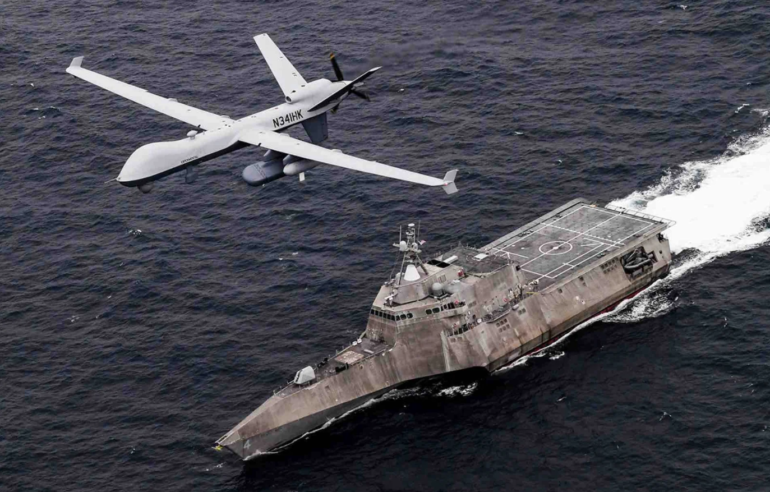TL;DR:
- Deputy Secretary of Defense Kathleen Hicks underscores the need for innovation in AI and autonomous technologies.
- China’s massive military buildup necessitates American innovation to match its progress.
- The Replicator Initiative, overseen by the Defense Innovation Unit, aims to harness AI drones for battlefield solutions.
- Replicator focuses on all-domain, attritable autonomous systems (ADA2) to counter China’s mass advantage.
- Ukraine’s use of cost-effective technologies demonstrates the potential of AI and drones in modern warfare.
- The Pentagon is actively investing in autonomous systems and ethical AI integration.
- Task Force Lima guides responsible AI integration in military and intelligence operations.
- Replicator seeks to deploy autonomous systems at scale within 18-24 months, prioritizing efficiency and cost-effectiveness.
- Replicator promises to revolutionize U.S. military innovation by embracing small, intelligent, and numerous platforms.
Main AI News:
In the fast-evolving landscape of global defense, innovation reigns supreme. This sentiment was underscored by Deputy Secretary of Defense Kathleen Hicks during her recent address at the Defense News Conference. In an era marked by strategic competition, particularly with China’s People’s Liberation Army (PLA), the United States recognizes the urgent need to harness the power of AI and autonomous technologies. The PLA’s massive military buildup, which accounted for 13% of the world’s total defense spending in 2022, has prompted a call for American innovation to keep pace.
Hicks boldly declared, “Our ability to deliver innovation at scale is not a pipe dream.” She drew historical parallels, invoking the industrial might that outpaced the Axis powers during World War II, the precision-strike capabilities honed during the Cold War, and the groundbreaking technologies utilized in the Gulf War and post-9/11 conflicts. All of these innovations stemmed from the operational needs of their times, and Hicks affirmed that such a moment is upon us again.
Enter the Replicator Initiative, a visionary AI drone program overseen by the Defense Innovation Unit. Hicks unveiled this initiative as a solution to bridge the production gap, emphasizing that it won’t result in additional budgetary burdens. “Not all problems need new money,” Hicks asserted, highlighting the Pentagon’s commitment to finding internal solutions.
Replicator’s primary focus lies in all-domain, attritable autonomous systems (ADA2) – a strategic move to counter China’s mass advantage. As Hicks aptly put it, “With Replicator, we’re beginning with all-domain, attritable autonomy to help us overcome the PRC’s advantage in mass: more ships, more missiles, more forces.”
The Ukraine conflict offers a compelling case study. Despite facing a militarily superior aggressor, Ukraine’s utilization of cost-effective technologies, including drones, showcases the formidable potential of such innovations. These low-cost, rapidly deployable technologies can deter larger adversaries, minimizing human exposure to danger and ensuring swift adaptability.
Hicks revealed that the Pentagon has been actively investing in autonomous systems across various domains, encompassing sea vessels, unmanned aircraft, and drones. The imperative now is to scale these systems, making them harder to anticipate, target, and defeat than those of potential rivals. Ethical considerations regarding AI and autonomous systems remain paramount, with the Department of Defense keenly aware of their implications.
Earlier this year, the DoD launched Task Force Lima, a generative AI initiative tasked with guiding the responsible integration of AI into military and intelligence operations. This, combined with the Replicator initiative, aims to deploy autonomous systems at a substantial scale within the next 18-to-24 months, not only prioritizing production volume but also efficiency and cost-effectiveness.
“All-domain, attritable autonomous systems will help overcome the PRC challenge of anti-access, area-denial systems,” Hicks asserted, underlining the importance of ADA2 in countering China’s anti-access strategies. Replicator seeks to revolutionize U.S. military innovation, embracing platforms that are small, intelligent, cost-effective, and numerous – a strategy poised to shape the future of defense.
As Hicks confidently stated, “Now is the time to seize this moment, to redefine the future of defense through Replicator and ADA2, ensuring our nation’s security in an ever-changing world.” The journey toward innovation at scale has begun, and the Replicator initiative promises to be a true game-changer in the world of defense technology.
Conclusion:
Replicator’s AI drone initiative represents a pivotal step in modernizing defense technology. As the U.S. seeks to maintain its competitive edge in an evolving global landscape, Replicator’s focus on cost-effective, agile, and ethically-integrated autonomous systems positions it as a game-changer in the defense market. It heralds a future where innovation at scale will redefine the defense industry’s landscape and capabilities.

